Projects
We have a number of ongoing projects which you can access by clicking on the heading.
We have a number of ongoing projects which you can access by clicking on the heading.
Past generations have already driven many indigenous British animals into extinction, so to reverse this dreadful situation FES supports reintroduction programmes whenever appropriate. Present avian reintroduction programmes include the White Tailed or Sea Eagle, and the Crane: mammals include the Beaver, Lynx, Wolf and European Bison.
FES supports these reintroduction plans and programmes because they follow the European Union's Directive 92/43/EEC Conservation of Natural Habitats and Wild Flora and Fauna (the Habitats and Species Directive) Article 22. With this legislation, as stated in Annex IV, the UK government must consider the reintroduction of extinct native species, whenever it is appropriate. Furthermore the 1992 Rio Earth Summit, a declaration which the British government signed, gave us our present orientation. Moreover;
As subscribers to the European Habitats Directive the British government are internationally required to "study the desirability of reintroducing [threatened] species" that have become extinct from our region.
But to get all of Britain's indigenous animals living in the countryside once more, the British public must want to live inside nature, rather than being disengaged or frightened by it. This is why FES raises awareness of these reintroduction programmes and helps keep the issue at the top of the public's conservationist agenda.
In many cases FES needs to explain the realities of these animals, as they often have 'a bad press' which suits their enemies. As a result they must endure a bad reputation which is usually untrue.
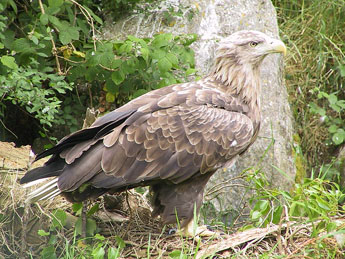 |
| White Tailed Sea Eagle |
| Talks Presenters 09 at English Wikipedia / CC BY-SA |
The White Tailed or Sea Eagle is also known as the 'barn door' because of its huge wings which measure up to 6 feet in length, and is the fourth largest eagle in the world. The adults have a large head, a large thick yellow beak, are usually brown except for the slightly paler head and neck, blackish flight feathers, and a distinctive white tail. Because some eagles have been known to live for 25 years they can breed for a long time which makes up for having only one or two chicks in a brood. During the 2016 FES expedition we monitored the mainland based eagles, and saw a pair in the mountains of Skye as well as one over the sea as it flew from the Isle of Rhum towards Soay.
The White Tailed Eagle's diet is varied depending on local habitats and the time of year. Depending on what is readily available their prey includes mammals, birds and fish. However many individuals are scavengers, stealing food from carnivores and other large birds, or eating carrion in the colder winter months when live food is scarce.
In 1975 a few dozen eagles were first reintroduced to the West coast of mainland Scotland as well as some of the islands including Rhum and Mull. Between 2007 and 2013 they have also been reintroduced to the east coast of Scotland, where they are being monitored. There are some signs that they will increase their numbers and territory.
There are more breeding pairs today than at any time recently although there is still a slow reproduction rate. So whilst the Scottish populations are gradually growing, both colonies need more support to establish the eagle as a common species. One recent count has a population of over 130 breeding pairs which has in reality, established a minimum viable population or MVP.
FES is advocating the establishment of an English colony in the Isle of Wight. Because FES has studied international parallel programmes that have been successful, we believe that this next plan of action is a feasible reintroduction policy. But, as always the actualization of such plans seems to be very slow progress.
Fortunately now there is talk of up to 60 juveniles to be released in the area which could develop into a MVP. Then we can look forward to increasing their range across the country.
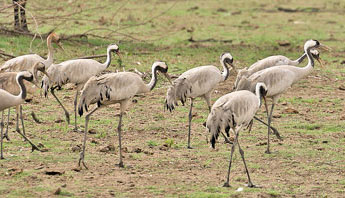 |
| Cranes by J M Gary |
The Eurasian (also called the Common) crane is one of Europe's tallest birds standing over three feet tall and with a wingspan of nearly seven feet. It is unmistakable, being coloured grey with long thin legs, a large body and long neck. About 400 years ago cranes were common in East Anglia, until it became a scarce visitor because mankind had continually drained their wetland nesting sites and hunting territories.
In the 1970s a small breeding population established itself in the Norfolk Broads which gave the chance for conservationists to increase the colony. Since those years the colony has grown, and they have even nested in Suffolk.
Meanwhile the Great Crane project for Somerset Moors and Levels has mixed habitats of wetlands as well as meadows and pastureland. In all, about a hundred birds (mainly eggs or chicks gathered from Germany) were released in 2015 which created a MVP that is hoped to create a successful and permanent colony.
There are now just over 50 breeding pairs. We can help them with some of their food as they eat vegetation including fruit, seeds, stems, leaves and roots. They also prey on small animals including dragonflies, snails, spiders, other insects, small birds and rodents.
FES is monitoring the development of both colonies and are prepared to act accordingly wherever necessary; they will also continue to report on their progress in the media.

The Beaver has been successfully reintroduced into the British countryside after an absence of about 500 years.
A good few years ago FES wrote to Louis MacDonald of the Scottish parliament to support the Beaver Reintroduction project at Knapdale Forest in Argyll. This original plan was rejected, for what FES believed was a lame excuse on behalf of the land owners' self interests. But shortly afterwards, the Scottish parliament and government changed, and the project was once more proposed to the new Scottish parliament. So FES wrote again in support of the plans to Richard Lochheart, the Cabinet Secretary for Rural Affairs and the Environment. This time the five year plan was given the go ahead.
The Scottish Beaver Trial ended some years ago in 2014, with the final decision being made on 24/11/2016 to allow them to be a permanent animal in our countryside. It was a truly historic date as it was the first formally reintroduced species of mammal (because the Wild Boar is re-establishing itself without government support).
Whilst there are many supporters of the Beaver, there is opposition too, mainly from self interested land owners who have the ear of many influential people in the powerful establishment.
FES not only supported the original reintroduction of the Beaver into Scotland, but also advocates more colonies throughout the country. This idea is gaining strength and there are plans for further controlled releases. FES welcomes the Tayside colony of Beavers, even though they were not controlled in a government programme. Farmers have opposed them because of the damage they do to the area. However with a proper compensation scheme, this opposition should decline.
FES advocates the re-introduction of the Beaver into England, especially as there have been other scientific programmes which predict that a new reintroduction programme in Devon, East Anglia and elsewhere. Understandably FES had welcomed the reintroduction trial of Beavers into the River Otter, Devon which seems to be going well, with a handful of breeding pairs. This is great news and gives FES confidence that the authorities will allow this creature to once again be a permanent feature of the British countryside wherever it should naturally be.
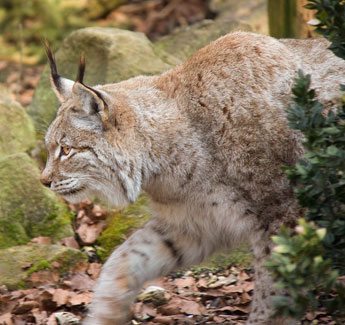 |
| European Lynx: Tony Hisget |
The Lynx once ruled our ancient woodlands but was hunted to extinction in the UK because it was considered a pest (and still is by the authorities).There is very little argument to immediately re-introduce this carnivore into the British countryside because of the lack of a feasible habitat to sustain a MVP.
So FES advocates the creation of such a habitat, which in reality, should be in northern England and Scotland. This may take a long time to create in itself, but once it is done then this project could become more of a reality.
Their main prey is deer, which according to official figures, are over populated. The reason for this over population is because the deer no longer have to worry about its natural predator. So everyone must put up with a nonsensical position of having too many deer but no natural predator. It is really a no-brainer, but we do not trust the authorities to act on this matter soon.
With the reintroduction of the Lynx, a profitable eco-tourist industry will develop which could sponsor a compensation scheme any group of people suffering from them. Whilst most farmers would not be hurt with this reintroduction plan, because lynx do not take livestock, anyone else out of pocket could still be reimbursed.
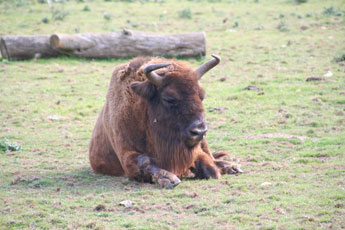 |
| European Bison |
The European Bison or Wisent is related to the North American bison or buffalo. Both animals have been near the brink of extinction but have made fantastic comebacks in the c20th.
However, as in many circumstances, Britain lies behind almost everyone else, and has not yet seriously considered re-introducing the Wisent into the British countryside. It has been extinct here for thousands of years and arguably disappeared in what was the British tundra in the last ice age. One must remember that, in those days, Britain was still connected to the continent with a huge landbridge that later became submerged.
The positive point for this re-introduction that it is 10% auroch (which is now globally extinct) and fits into the eco-system as a herbivore. Despite its reputation as an unpredictable animal it has been successfully reintroduced into many continental countries without too much fuss.
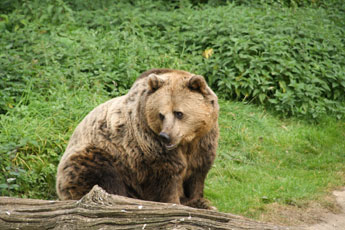 |
| Brown Bear |
The Brown Bear became extinct in the c17th due to excessive hunting. In the 1500s bears were used in Southwark in the (in)famous Bear Baiting Pits adjacent to old theatres including the Rose and the Globe. The modern Globe theatre now stands almost next to the original 'Bear Baiting Pit'. Here dogs were set upon them for sport and gambling.
Times have changed, and we have changed considerably since then, although some people would still hunt them with rifles, if they had the chance. However many of us would prefer to see them in the wild again and wonder upon their glory as a top range predator.
But because of its power, dangerous and carnivorous nature, it is unlikely to be allowed to roam free for some years yet. It is a woodland animal that will co-exist with other carnivores including the Lynx. So FES advocates more woodland, not only for deer, boar and many other species, but also the top predators. These large predators will naturally control the numbers of these grazers and browsers and help the woodlands regenerate and grow by themselves. The key is, as in many cases, habitat growth and management should be the first focus, and then a normal re-introduction plan based on how bears live in other countries. A simple parallel is often sufficient to begin.
The glade has been regularly walked and monitored .to make sure that nothing was amiss. Whilst it is an interesting habitat, in the winter it can be seen as bleak and uninspiring. Don't be fooled by it! There are many species of trees, with bushes and flowers living in the undergrowth and on the sides of the banks. Lots of garden and field birds regularly inhabit and visit the reserve, as well as water birds: mammals include brown rat, water vole, foxes, bats and badgers.